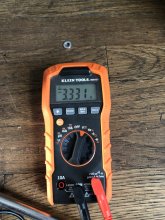snailturtle
New Member
- Joined
- Feb 23, 2021
- Messages
- 1
First time posting! I need some help. I'm currently top balancing my 3.2 volt 105ah new lifepo4 batteries.
Their original state of charge was about all 3.29 v or so. After a hour of charging it is up to 3.333. My concern is that my DC bench charger is only give out .971 of current. When I started it was a little higher, like .98 or so. My understanding is that the batteries dictate how much current it receives and that once the current drops to .1 the cells are considered charged. However, since the charger is capable of charging by up to 5a the current rate seems pretty low and that this process is going to take forever...
Does this seem sensible to those seasoned veterans of the solarverse. Is something wrong with my DC charger?? Any help would be appreciate!



Their original state of charge was about all 3.29 v or so. After a hour of charging it is up to 3.333. My concern is that my DC bench charger is only give out .971 of current. When I started it was a little higher, like .98 or so. My understanding is that the batteries dictate how much current it receives and that once the current drops to .1 the cells are considered charged. However, since the charger is capable of charging by up to 5a the current rate seems pretty low and that this process is going to take forever...
Does this seem sensible to those seasoned veterans of the solarverse. Is something wrong with my DC charger?? Any help would be appreciate!






